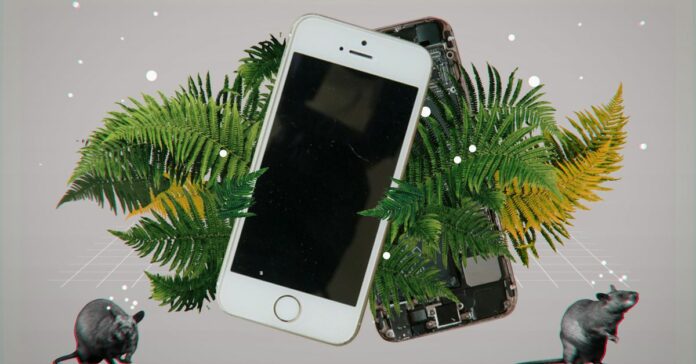When humans cut their way through forests to dig up gold and other minerals that go into phones, computers, and other devices, they run the risk of being a catalyst for a phenomenon called “spillover.” That’s what happens when a virus makes the leap from one species to another. It’s how two-thirds of new infectious diseases, like COVID-19, emerge.
The novel coronavirus that has infected more than 10 million people, killing more than 500,000 worldwide to date, began as an animal virus. The virus got the opportunity to jump from one species to another, and it eventually landed in a human. Researchers first thought that the virus made the leap from animals in a marketplace in Wuhan, China. But there are plenty of other situations humans create that make it easier for novel viruses to reach us, including mining. The Verge dug into a smartphone and connected the dots between the minerals inside and the potential for another new virus to wreak havoc across the globe.
“Our choices as consumers … cause miners to go in there and come in contact with wild animals that carry viruses. We implicate ourselves in this chain of consumer supply and demand,” says David Quammen, author of the book Spillover: Animal Infections and the Next Human Pandemic. “That is one of the broader causes of contact with wild animals that leads to spillover of new viruses with the potential of becoming epidemic and pandemic,” says Quammen.
Take gold, for example, which is used in a lot of electronics because it conducts electricity pretty well. Marburg, a viral hemorrhagic fever similar to Ebola, killed 128 people in Congo between 1998 and 2000. Scientists surmised that gold miners probably picked up the virus from animals, like bats, in mines, and the virus spread from there. That’s just one of several instances of spillover related to mining that The Verge came across as we were researching this video.
It’s not just gold that’s a concern, either. Like gold, a metallic ore called coltan (short for columbite-tantalite) is highly sought-after by electronics manufacturers. It’s used to make tantalum capacitors that control the flow of electricity through a circuit board. Because both gold and coltan are valuable in small quantities, they’re also attractive to subsistence miners. Subsistence mining, also called artisanal or small-scale mining, is done informally — often with little more than shovels, picks, and pans.
A majority of coltan is mined at this small scale in Congo. And compared to big, industrial operations, small-scale mining comes with a lot more chances for viruses to “spill over” from animals to humans, experts say. For instance, subsistence miners working in remote areas might not have access to food markets, so they’re more likely to hunt for food that could make them sick. Our latest video explores the different ways a miner might contract a new virus and unintentionally trigger an outbreak.
:no_upscale()/cdn.vox-cdn.com/uploads/chorus_asset/file/20069280/677702304.jpg.jpg)
Ultimately, the way humans interact with animals and the environment can have grave consequences for our own well-being. That’s why scientists and public health experts have developed a strategy for addressing the ways in which the health of the environment and all of the people and wildlife living in it are connected. It’s an approach called “one health.” It brings together experts from different disciplines — from conservation biology to medicine — to keep people and the planet healthy. The idea has been around for decades, but the approach gained a lot of traction after outbreaks of another coronavirus, SARS-CoV (which was thought to have originated in bats), in 2003.
“It’s one world, one health, because we all live in the same place,” says Carlos Zambrana-Torrelio, an associate vice president for conservation and health at the nonprofit EcoHealth Alliance. “We are part of the animal kingdom. So we need to understand that that’s the reason we share all these viruses with animals,” he says.
There are ways to lessen the risk of virus spillover from mining and other extractive industries, according to Zambrana-Torrelio. It mostly entails having a more controlled environment when mining: performing environmental impact assessments, ensuring that there is safe food for miners to eat, and that there are rules against hunting for bushmeat while on the job. The United States Agency for International Development (USAID) has also developed recommendations for minimizing the risk of new diseases emerging in mining camps, which includes monitoring workers’ health and keeping an inventory of the local wildlife. But all of that is hard to do when it comes to informal, often illegal, subsistence mining.
EcoHealth Alliance, working in partnership with USAID since 2009, has found 1,200 new viruses — including more than 140 coronaviruses. It only takes one of those to throw the world into another pandemic. Anywhere we destroy habitats by doing things like mining for minerals, we’re not just harming the environment — we’re potentially setting ourselves up for another global crisis.






